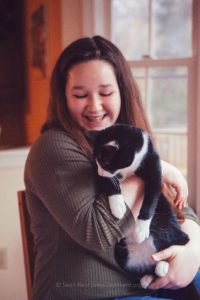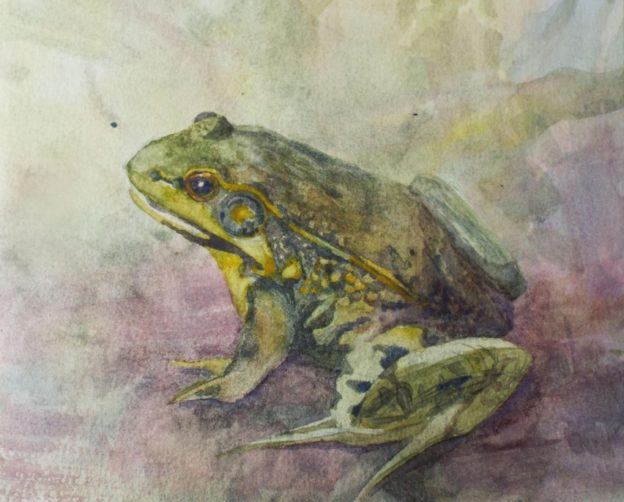Keep a lookout for the many amphibians that live at MABA! Although all amphibians spend part of their life in water, each species lives in a different habitat. Because of this, you can find them all over the MABA property! I have seen them by the vernal pool, pond, brook, as well as by the sides of the trails.

Yellow spotted salamander in ink and watercolor; eastern red-backed salamander in watercolor
Salamanders can be found by the brook, usually near or under rotting logs. There are two main species at MABA: the yellow spotted salamander and the eastern red-backed salamander. The yellow spotted salamander is mostly black with yellow spots. The red-backed salamander has a reddish-orange stripe down its back, and tends to have a longer, thinner body. At first glance, you may mistake a red-backed salamander for a small snake.
Frogs are by far the most common amphibian at MABA, and green frogs are the most common of them all! By the pond at the back of the sanctuary, they will come and sit just a few feet away from me. They range from 2” to 3.5” in length. I have noticed a lot of variety in the coloring of green frogs: some (like the one pictured) have more green spots, and others appear more grayish green.

Green Frog in watercolor
Pickerel frogs are about 2.5” in length and have distinctive black and brown markings on their bodies. When the frogs are in the water and only their head is visible, try and notice if there are any black markings by the eye. This can help you distinguish pickerel frogs from green frogs.

Pickerel frog in ink and watercolor
Of the MABA frogs, the Wood Frog seems to live the farthest from the water. Often on the trails by the edge of the brook, Wood Frogs are mostly tan or light brown with a dark stripe by their eye.

Wood frog in watercolor and marker
Frogs and toads are quite similar, but toads tend to have dry skin and live farther from the water.
American Toads, which are the only species that I have seen at MABA, are tan or brown and have spotted, bumpy backs. Below is a drawing of two of the toads I have seen: the larger, older one was about 3” long and the smaller one was only 1” long. Both were seen on the Main Loop Trail.

American toads in ink
This larger American Toad was being preyed upon by a garter snake when I approached. When it heard me come closer, the snake slithered away and left the toad alone.

If you cannot get a picture of an amphibian you see, it is helpful to remember its size, coloring, markings, and location so that you can identify it later. A quick sketch might help as well!
My name is Maris Van Vlack, and I will be blogging for the summer of 2020! I am a rising sophomore at the Rhode Island School of Design, with a major in Textiles and a concentration in Drawing. I used to take homeschool classes at the Museum of American Bird Art and have had my artwork exhibiting in their Taking Flight Exhibit for young bird artists.
I am especially interested in working with unusual materials in my work, and am inspired by plants, animals, and the patterns found in nature. This summer, I will be creating a guide for the MABA trails with sketches and paintings. I will be recording and writing about my observations, and sharing them through these blog posts. Hopefully this will be an educational and inspiring resource, and will motivate you to sketch what you see when you visit MABA this summer!




Thank you, Maris, for all your blogs and careful observations.. My favorite so far are the frogs.. each of your illustrations gives them character .. almost personality..And how wonderful that you have been wandering the paths of the MABA sanctuary and taking us along on your walks… helping us pause and observe and respond with wonder at all you have cleverly unveiled to us along the way. And I love your trying different renderings.. Pencil, Watercolor, ink, marker.. each giving different life to your drawings. I look forward to your guide.. stretching our understanding of the MABA trails. Thank you!
Hi Faith,
Thank you so much for reading and following along. We are so lucky to have had Maris at MABA this summer. Thanks and look for two more posts in the future. Be well.
Best,
Sean